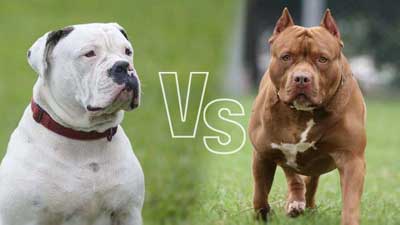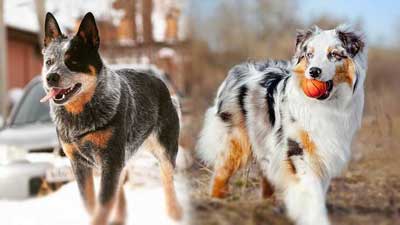- Size
- Smallest
- Small
- Small to Medium
- Medium
- Large
- Giant
- Characteristics
- Smartest
- Hypoallergenic
- Fluffy
- Best Guard
- Best Family
- Best for Kids
- Low Shedding
- Healthiest
- Police Dogs
- Most Calm
- Quietest
- Color
- White
- Black
- Grey
- Brown
- Blue
- Red
- Coat
- Hairless
- Short
- Long
- Origin
- Japan
- China
- Australia
- Germany
- Italy
- United States
- France
- Group
- Hound
- Terrier
- Herding
- Toy
- Working
- Sporting
Belgian Malinois vs. German Shepherd: Which Is Better?

Both the Belgian Shepherd and the German Shepherd are working dogs created in Germany for herding sheep. Both dogs have a high work ethic and determination and are currently used by police, military, and civilian defense.
Which dog is the better family dog? The depends on a variety of factors that need to be considered by the potential owner.
The first step is understanding a little bit about each breed. First, is the Belgian Shepherd.
- 1. Belgian Shepherd Pros and Cons
- 2. German Shepherd Dog Pros and Cons
- 3. How to Choose
- 4. Final Verdict
Belgian Shepherd

The Belgian Shepherd consists of three different types of dog: the short-haired Belgian Malinios (this dog closely resembles the German Shepherd) and the long-haired, black Belgian Shepherd, also known as the Belgian Sheepdog.
Belgian Malinois are large, but slender dogs with either a fawn, mahogany, or black coat. Most dogs have a black mask around the nose. The average weight for female Malinois is 44-55 lbs and a male is heavier at 55-66 lbs. Belgian Sheepdogs, on the other hand, are only found in black. The females of this breed are 45-60 lbs and the males are 55-75 lbs.
Of the two types of shepherds, the Malinois is the most frequently seen. The Belgian Sheepdog is intelligent, active, loyal, and protective. They can pick up commands quickly The average lifespan of a Malinois is 10-12 years. The average lifespan of a Sheepdog is 12-14 years.
Belgian Malinois Pros
- One of the biggest advantages of owning a Malinios is that this dog is easy to train. They are obedient and catch onto commands easily. This breed is easily house trained.
- Malinois are by nature protective, but not aggressive, dogs. These dogs tend to slightly reserved when meeting new people and dogs, but not shy. However, dogs trained for protection tend to have a higher prey drive than those kept as pets.
- Malinois can get along with children and other pets as long as the dog is socialized. These dogs form a deep and loving bond with their owners and are happy to work. These active dogs can take part in dog sports such as agility. The Belgian Sheepdog looks similar to a long-haired black German Shepherd.
Belgian Malinois Cons
- Aggression is one of the main concerns of this breed. Although a well-bred shepherd should not be overly aggressive, this can occur in some lines. Dogs that are used for protection tend to have a higher prey drive, and thus be more aggressive than those from pet lines.
- This high prey drive means that Belgian Shepherds can chase smaller animals such as cats or small dogs. They also tend to be dominant with dogs of the same sex. This dog will not handle rough training, and the potential owner should invest in positive reinforcement techniques.
- These dogs are heavy shedders. Their coat tends to "blow out" during the fall and summer. The Malinois sheds less than the sheepdog. However, the potential owner will find large amounts of hair on the furniture and clothing!
- The biggest drawback is that these dogs require a heavy investment in exercise, up to two hours each day. This dog will not be satisfied with a walk around the block but needs jogging, biking, or hiking to be kept happy.
- This dog is also highly intelligent so he or she needs to be challenged both mentally and physically. They can become destructive when bored and can chew, dig holes, or escape from yards.
- This dog should participate in Schutzhund, advanced obedience training, fly ball, Frisbee, or agility to help stave off both boredom and destructive behavior. The requirements needed by this dog is usually too much for the average owner.
German Shepherd Dog

The German Shepherd Dog (GSD) is a highly intelligent dog used in by the police and military in a variety of tasks. This is one of the most widely used breeds in the world.
The German Shepherd comes in both short-haired and long-haired varieties. The German Shepherd comes in different colors: tan with a black saddle (most common) black, sable, or the very rare panda color (not recognized by most clubs). Even though white GSD do exist, they are not recognized by most official clubs or used by police and military.
The average lifespan of a GSD is 9-13 years. Females weigh an average of 49-71 lbs and males are heavier at 66-88 lbs. German Shepherds are intelligent, loyal, patient, and protective.
German Shepherd Pros
- The GSD can fulfill many roles and is used by a wide variety of agencies for different purposes. GSD possesses a high level of intelligence. This makes obedience and house training this dog easy. They respond well to both basic and advanced training.
- The German Shepherd are handsome dogs with a regal look that have a commanding presence. GSD can adapt to a variety of weather from colder temperatures to more moderate temperatures (they do not do well in high heat). German Shepherds are also loyal to their owners and develop a deep bond. They thrive on having a job to do and can compete in agility, Schutzhund. and fly ball, among others.
- GSD can get along with other dogs, animals, and children, as long as they are socialized... The natural protective instincts of GSD makes them great guard dogs. They do not require a large amount of bathing. These dogs are active and love to walk, run, or jog. GSD also likes to go swimming, especially on hot days.
German Shepherd Cons
- Shedding is probably one of the biggest flaws of the German Shepherd. Those that own a German Shepherd sometimes call them "German Shedders!: They have an undercoat and topcoat that will blow out twice a year. They also require large amounts of grooming throughout the rest of the year with a brush and grooming rake.
- German Shepherd does not like to be left alone for long periods and can develop separation anxiety. They can become very attached to one person in particular. These dogs need lots of physical and mental activity from one to two hours daily. GSD does best with brisk walking (using a dog backpack to add challenge), jogging, hiking, or swimming. They can bark a lot if left alone out of frustration and boredom. They need to be a part of the family.
- GSD also tends to suffer health problems such as bloat, hip disorders, and hemophilia. The popularity of GSD has led to many puppy mills and backyard breeders. Many GSD may suffer aggression problems from certain lines. This is one of the biggest concerns as many insurance companies may charge homeowners larger amounts of money for owning this dog. Even though GSD are protective, they should not be aggressive. Many owners neglect to exercise a GSD leading to a frustrated dog that is destructive or a nuisance barker.
How to Choose
Which Makes the Better Family Dog?
The best family dog for the majority of owners would be the German Shepherd Dog. Many families can meet the exercise need of a well-breed, medium energy German Shepherd. These dogs are easy to train and can get along well with children and other animals. Families should look for a dog with a lower prey drive, and look for dogs from pet lines rather than working lines which tend to be higher energy.
German Shepherds can adapt to a variety of activities and do well in the suburbs or country. German Shepherds are not only more readily available from good breeders, but many rescue groups specialize in this breed as well.
Which Breed is the Better Police Dog?
Both breeds may be tied in this respect as they both make excellent police dogs.
However, the German Shepherd is the most widely used dog in the world. The military also uses German Shepherds, but Belgian Shepherds are also used as detection dogs.
The Belgian Sheepdog has a high amount of energy and focus and can be difficult for the average owner, thus, they are best used in a police or military capacity.
Final Verdict
Both breeds are highly intelligent and trainable dogs. Both types of dogs were originally bred to herd sheep and do well in obedience.
The Belgian Shepherd has a higher energy level of the two breeds and needs a specific and focused job to be happy.
The German Shepherd also needs a job but can fit in more easily with a family. German Shepherds tend to have a lower prey drive overall and are thus best suited for the majority of families.
References
- [1] ^ YouTube video: Dog Breed Comparison: Belgian Malinois vs German Shepherd
- [2] ^ American Kennel Club: German Shepherd vs. Belgian Malinois: What’s the Difference?
You May Also Like
 Breed ComparisonPresa Canario vs. Cane Corso: Which Is the Better Guard Dog?
Breed ComparisonPresa Canario vs. Cane Corso: Which Is the Better Guard Dog? Breed ComparisonAmerican Bulldog vs. Pit Bull: Which is Stronger?
Breed ComparisonAmerican Bulldog vs. Pit Bull: Which is Stronger? Breed ComparisonMiniature American Shepherd vs. Australian Shepherd: Which Is Better?
Breed ComparisonMiniature American Shepherd vs. Australian Shepherd: Which Is Better? Breed ComparisonAlaskan Husky vs. Siberian Husky: Which Is Better?
Breed ComparisonAlaskan Husky vs. Siberian Husky: Which Is Better? Breed ComparisonAustralian Cattle Dog vs. Australian Shepherd: Which Is Better?
Breed ComparisonAustralian Cattle Dog vs. Australian Shepherd: Which Is Better? Breed ComparisonAlaskan Malamute vs. Siberian Husky: Which Is Better?
Breed ComparisonAlaskan Malamute vs. Siberian Husky: Which Is Better?